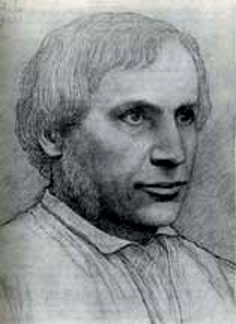| Alfred Stevens  Born: 28-Jan-1818 Born: 28-Jan-1818
Birthplace: Blandford, Dorset, England
Died: 1-May-1875
Location of death: London, England
Cause of death: unspecified
Gender: Male
Race or Ethnicity: White
Occupation: Sculptor Nationality: England
Executive summary: Monument to Wellington British sculptor, born at Blandford in Dorset on the 28th of January 1818. He was the son of a house painter, and in the early part of his career he painted pictures in his leisure hours. In 1833, through the kindness of the rector of his parish, he was enabled to go to Italy, where he spent nine years in study, at Naples, Rome, Florence, Milan and Venice. He had never been at an English school. In 1841 Thorwaldsen employed him for a year in Rome. After this he left Italy for England, and in 1845 he obtained a tutorial position in the School of Design, London. This post he occupied until 1847. In 1850 he became chief artist to a Sheffield firm of workers in bronze and metal. In 1852 he returned to London. To this period belongs his design for the vases on the railings in front of the British Museum, and also the lions on the dwarf posts which were subsequently transferred to the inside of the museum. In 1856 occurred the competition for the Wellington monument, originally intended to be set up under one of the great arches of St. Paul's Cathedral, though it was only consigned to that position in 1892. Stevens agreed to carry out the monument for £20,000 -- a quite inadequate sum, as it afterwards turned out. The greater part of his life as a sculptor Stevens devoted to this grand monument, constantly harassed and finally worn out by the interference of government, want of money and other difficulties. Stevens did not live to see the monument set up -- perhaps fortunately for him, as it was for many years placed in a small side chapel, where the effect of the whole was utterly destroyed and its magnificent bronze groups hidden from view. Stevens was aware of the position finally decided on for the work, and he suppressed the equestrian group intended for the summit and left the model for the latter feature in a rough state. On the removal of the monument from the chapel to the intercolumnar space on the north side of the nave for which it was originally designed, the model of horse and man was placed in the hands of an able young sculptor, trained mainly in another school, to be worked upon and cast in bronze. The incongruity of the idea did not strike those responsible for the proceeding. Its completion was still not carried into effect in 1910, after years of work and polemics, and it was feared that it would have a disastrous result on the masterpiece as a whole. Indeed the president of the Royal Institute of British Architects declared that the structure would not bear the weight of the addition. The monument itself consists of a sarcophagus supporting a recumbent bronze effigy of the duke, over which is an arched marble canopy of late Renaissance style on delicately enriched shafts. At each end of the upper part of the canopy is a large bronze group, one representing Truth tearing the tongue out of the mouth of Falsehood, and the other Valor trampling Cowardice underfoot. The two virtues are represented by very stately female figures modelled with wonderful beauty and vigor; the vices are two nude male figures treated in a very massive way. The vigorous strength of these groups recalls the style of Michelangelo, but Stevens's work throughout is original and has a very distinct character of its own. Owing to the many years he spent on this one work Stevens did not produce much other sculpture. In Dorchester House, Park Lane, there is some of his work, especially a very noble mantelpiece supported by nude female caryatids in a crouching attitude, modelled with great largeness of style. He also designed mosaics to fill the spandrels under the dome of St. Paul's. Stevens died in London on the 1st of May 1875.
Do you know something we don't?
Submit a correction or make a comment about this profile
Copyright ©2019 Soylent Communications
|